Hoatzin Profile
While the bush tyrant is the most likely of all the birds to have been named by Jim Henson, this remarkable runner-up appears to be the product of a love affair between David Bowie and a Skeksis.
The Hoatzin, pronounced ‘Hwat-zin”, is a peculiar tropical bird species found in South America, that has puzzled taxonomists for as long as it’s been observed.
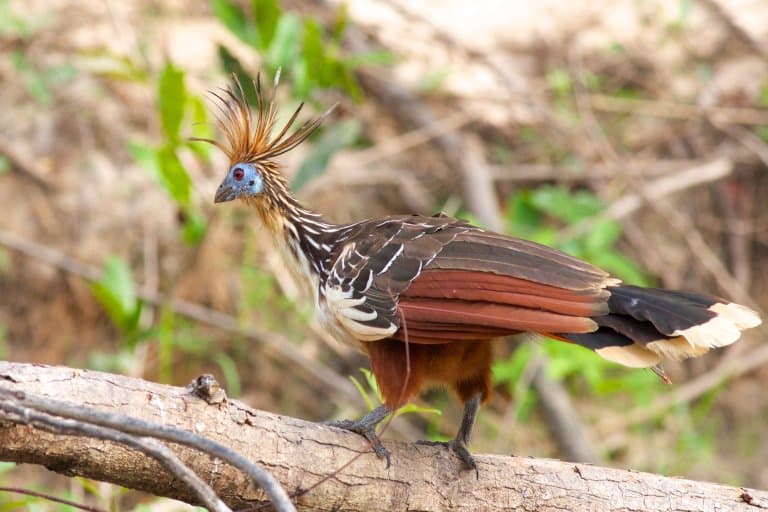
Hoatzin Facts Overview
| Habitat: | Forest and wetlands |
| Location: | Northern and Central South America |
| Lifespan: | 15 – 30 years |
| Size: | 65cm (26in ) long |
| Weight: | 700 – 900g |
| Colour: | Dark grey outer plumage with red crest and underwing, blue eyes, golden breast |
| Diet: | Leaves, mostly legumes, some fruit and flowers |
| Predators: | Great black hawks, monkeys, snakes |
| Top speed: | Slow |
| No. Of species: | 1 |
| Conservation status: | Least Concern (IUCN) |
They are the only member of their genus Opisthocomus, which comes from Ancient Greek and translates to ‘wearing long hair behind’, in reference to their striking large crest.
Hoatzin inhabit swamps, riparian forests, and mangroves of the Amazon and the Orinoco basins, where they spend their time eating leaves, as well as the occasional flower and fruit.
They grow up to around 65cm in length, or roughly the size of a pheasant. They are sometimes referred to as the ‘Canje pheasant’, or the skunk bird, or reptile bird.
They have some very primitive characteristics and isn’t the most agile for a flying bird up in the trees, but it does well with its loud voice and clever defence mechanisms.
It also has a gut that resembles that of a farm animal.
Interesting Hoatzin Facts
1. Nobody knows what it is
Hoatzin is quite clearly a rapper’s stage name, and this goes some way to obscuring the true lineage of its ancestors.
While recent research has narrowed things down a lot more, this bird has been placed among chickens, cuckoos, and various other clades in an attempt to figure out just what’s going on here.
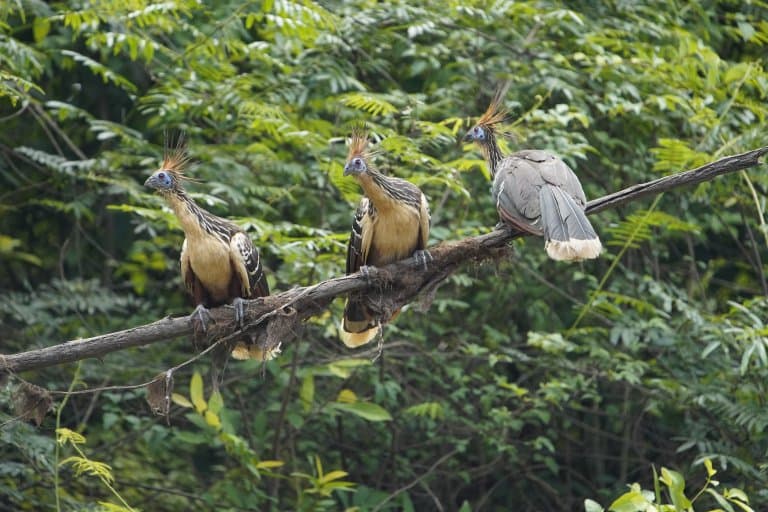
2. This chick’s got claws
One thing that makes it peculiar is the claws present in the wing tips of the young birds.
Hoatzins build their nests over water, and the young are clumsy little things. Having clawed hands helps them clamber through the branches and occasionally fight off eagles.
3. And a serious set of pipes
These are loud birds. Their most common call is a huff that sounds somewhere between a gorilla and a wood saw, and it’s a grating, noisy affair that carries across the rainforest.
They’re also capable of groans, croaks, hisses and grunts, which they use in different contexts.
When threatened by a predator, adults will flap about making all manner of alarm calls, using their outstanding voices to overwhelm and confuse their foes as the young try to fend it off with their finger talons.
Even when they’re not agitated, they seem to wander about loudly huffing. 1
4. They’re leaf-eaters
Even their diet is unusual. There are very few birds that eat exclusively leafy vegetation, and this is one of them.
While it’ll go for some fruit on occasion, the diet of a hoatzin comprises almost entirely of leaves. One of the ways they make this work is by having an equally-uncommon digestive system.
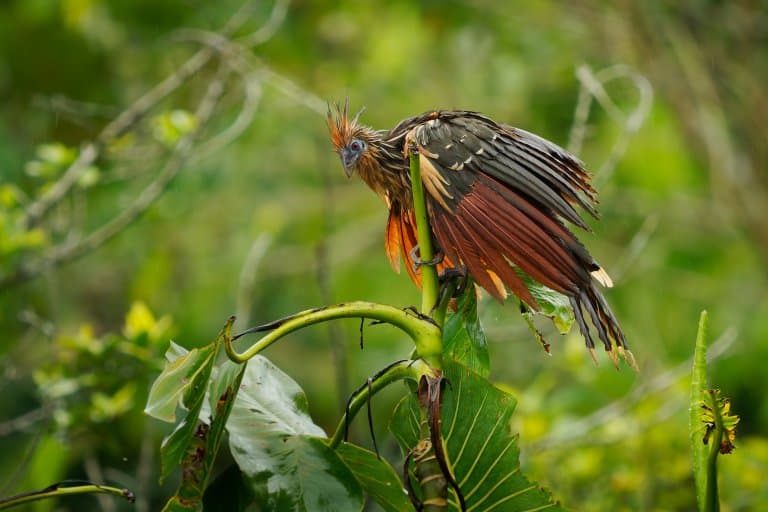
To help balance itself on the branches, the hoatzin uses a leathery bump on the bottom of its crop.
5. They’re ruminants
Most birders don’t spend a lot of time cutting into bird guts the way they might with a cow or a goat, and this may explain why it’s only recently been discovered that some birds are also ruminants.
Ruminants are traditionally hooved animals with multiple stomachs, capable of extracting the majority of useful nutrients from roughage in a process that involves fermentation, chewing their own puke, and various stomach sacs and digestive stages.
But the Hoatzin has shown us that it’s not just a perk of certain mammalian digestive systems, birds can do this too.
At least, the Hoatzin can, and at least two other species, discovered since this was found out.
The necessary gut bacteria for foregut fermentation in hoatzins comes, as is often the case, via a gooey, bacteria-ridden parcel, regurgitated into its mouth by a parent.
This discovery has further scrambled the bird’s possible taxonomic lineage.
6. The are pretty stinky!
The hoatzin is also known as the ‘stink bird’ or ‘skunk bird’, as it’s said they smell like fresh cow manure.
Due to their diet and digestive system similar to cows, their meals ferment in their stomachs. Its strong scent serves to deter predators as well as to attract mates.
They were named in our The Smelliest Animals In The World list. 2
7. They suck at flying
All this extra gut makes them a weighty bird. The crop alone can be 17% of its body weight, and to make space for this extra digestive stuff, the flying muscles are small and reduced.
It can fly, but much like a chicken, it’s far more adept at flapping about loudly. When full of food, they rest their extended belly on the branch to take a load off. 3
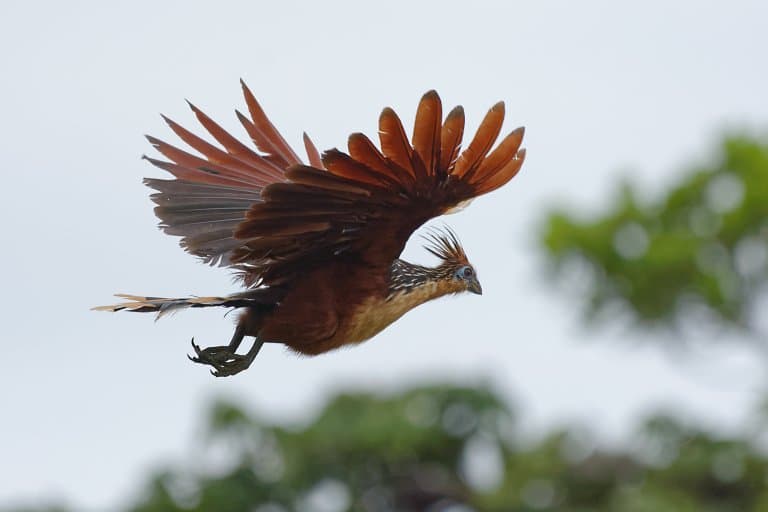
8. It might be one of the most primitive flying birds in existence
Most people understand that birds descended from dinosaurs, but it’s a little-known fact that birds are dinosaurs. Of all the lineage of dinosaurs that existed 66 million years ago, only one survived: the therapods.
By this time, dinosaurs had long had feathers, and many could probably fly. It’s thought archaeopteryx could get some serious air as far back as 150 million years ago, so avian dinosaurs had long been in the making by the time of the extinction.
Of course, after the extinction event, about a gazillion new niches opened up for the survivors, so evolution quickly set to work modifying everyone to fill them. One hypothesis for the origin of Hoatzin was that it diverged around this time, with its ancestors showing up around 65 million years ago.
This could make it one of the most ancient birds in existence. And the claws on its hands definitely corroborate this – ancient birds like archaeopteryx had these too! Though these may have disappeared and reappeared over the course of the animal’s evolution. 4
9. They can swim
If you thought dragging themselves around on dinosaur claws wasn’t weird enough, hoatzin chicks have another trick up their wing.
While the claws can be used in defence, if that doesn’t go to plan, they can drop out of the nest and into the water below, a medium they’re quite comfortable swimming in, submerged, until the threat is gone.
10. They’re doing ok for now, but populations are declining
The sheer size of the Hoatzin’s range gives it an ecological advantage, and population numbers look good; though there’s no set estimate for just how many there are.
However, the population is decreasing, and though this doesn’t spark concerns in terms of conservation just yet, it’s possibly a sign of worse to come.
Populations of animals will naturally fluctuate and can often bounce back or stabilise, but the hoatzin is projected to lose around 20% of its habitat over three generations, and the factors affecting this aren’t going away any time soon.
Locally, they’re eaten by humans, and internationally they’re subjects of illegal pet trading. Still, for now, they’re not close to becoming threatened. 5
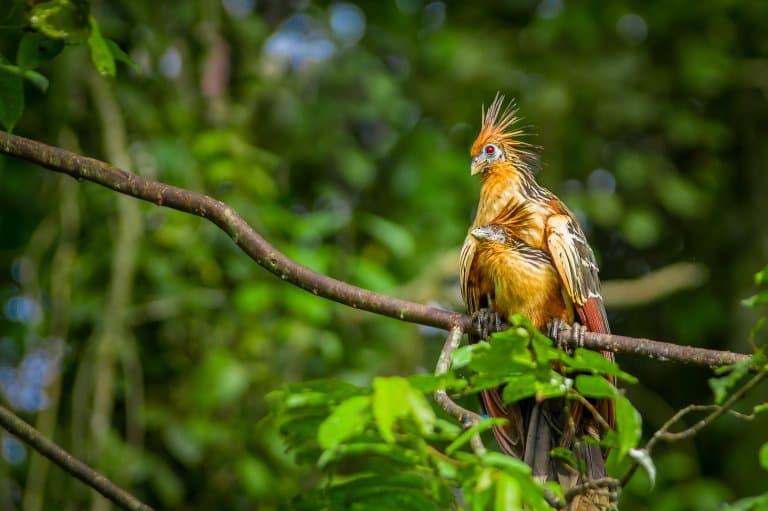
11. The hoatzin is the national bird of Guyana
Guyana is a country on the northern mainland of South America.
They can be found throughout the year in the country – along the Berbice River and its tributary, the Canje Creek, and to some extent, on the Abary, Mahaicony and Mahaica Rivers.
Hoatzin Fact-File Summary
Scientific Classification
| Kingdom: | Animalia |
| Phylum: | Chordata |
| Class: | Aves |
| Order: | Opisthocomiformes |
| Family: | Opisthocomidae |
| Genus: | Opisthocomus |
| Species: | Opisthocomus Hoazin |
Fact Sources & References
- “Hoatzin”, eBird.
- Liz Langley (2013), “5 Animals With Stinky Defenses“, National Geographic.
- Richard Pallardy, “Dirty birdies: The case of the stinking bird“, Earth.
- “A comprehensive phylogeny of birds (Aves) using targeted next-generation DNA sequencing“, Nature.
- “Opisthocomus hoazin“, IUCN Red List.
